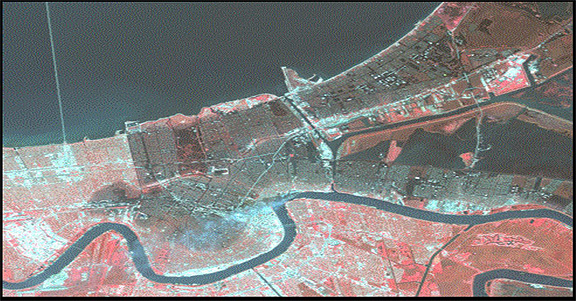The agencies honored the Eagle Vision program with the 2010 William T. Pecora award during a Pentagon ceremony Feb. 15. Eagle Vision was recognized for domestic and international contributions to homeland security, humanitarian aid and natural disaster recovery efforts. The system consists of five deployable satellite downlink stations that collect and process near-real-time optical and synthetic aperture radar imagery from commercial satellite constellations. It ensures that U.S. forces or disaster responders have current, high-resolution imagery of an area of interest.

Eagle Vision provides rapid, high-quality imagery, such as this image taken in the aftermath of Hurricane Katrina, that can be used by disaster response workers. Officials from NASA and the U.S. Department of the Interior honored the Electronic Systems Center-managed Eagle Vision program with the 2010 William T. Pecora award during a Pentagon ceremony Feb. 15, 2011. (Eagle Vision image)
"The system provides unclassified, releasable and high-quality imagery to first responders," said Capt. Jason Moll, the program manager. "These pictures are more than sufficient to meet disaster response effort needs." Eagle Vision imagery also can be exploited quickly, often within a few hours, he said. Processing time, though, ultimately depends on the amount of refinement — adding in street names, etc. — required by the end-user. The program developed as a result of calls from warfighters, following Operation Desert Storm, for timely, unclassified imagery they could share with combat allies. "However, the system has demonstrated phenomenal capability outside the combat zone," Captain Moll said.
Among recent notable incidents, the Eagle Vision imagery collection team here sprang into action within hours of the 7.0 earthquake that devastated much of Haiti last year. Two Eagle Vision units provided Haiti earthquake first responders with images within 24 hours of the quake. Disaster response officials used the satellite imagery to plan, prioritize and optimize their actions, often comparing overlays that contrast current conditions with pre-disaster imagery. The program also has aided many other natural disaster relief and humanitarian efforts, including responses to the California wildfires and to Hurricane Katrina. Outside the United States, the Eagle Vision team provided support to 19 different disaster relief efforts in six different countries during 2009. Units also were deployed to Africa between 2004 and 2007 to collect commercial satellite imagery of Chad, Mauritania, Uganda and Niger to build a broad-area geospatial library for humanitarian support.
The award was presented to James G. Clark, Air Force director of Intelligence, Surveillance and Reconnaissance Innovations and deputy chief of staff for ISR. NASA Chief Scientist Waleed Abdalati and Anne Castle, Interior's assistant secretary for water and science, made the presentation. Officials from NASA and the Department of the Interior present individual and group Pecora Awards to honor outstanding contributions in the field of remote sensing and its application to understanding Earth. The award was established in 1974 to honor the memory of William T. Pecora, former director of the U.S. Geological Survey and undersecretary of the Department of the Interior.

